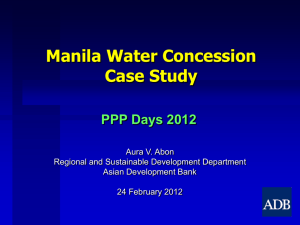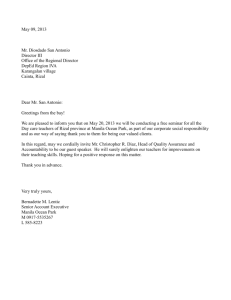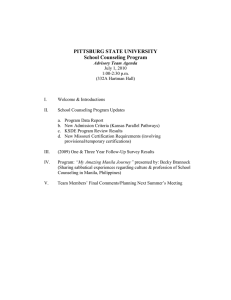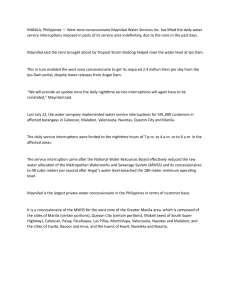Water Services for the Poor – the Manila experience Paris, France
advertisement
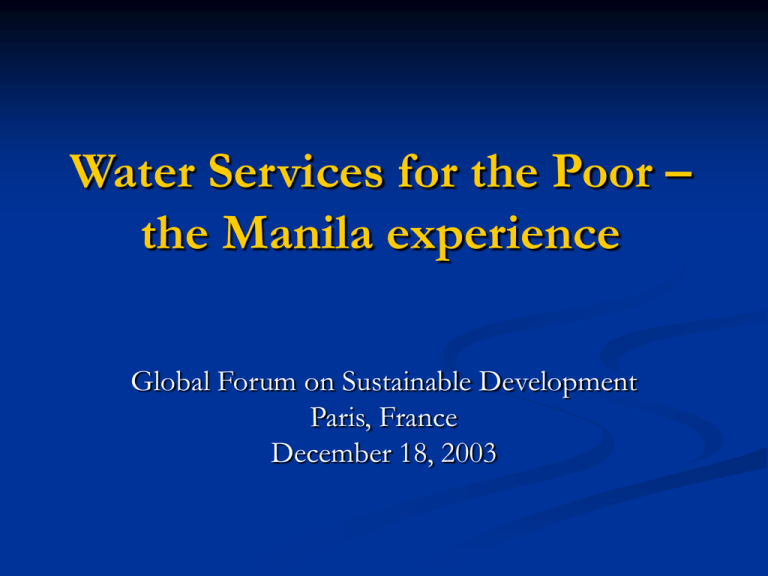
Water Services for the Poor – the Manila experience Global Forum on Sustainable Development Paris, France December 18, 2003 Manila experience 2 concessions granted to the private sector for water utility in 1997 After 6 years, more than a million poor people have received direct connections. Poor received numerous benefits: Financial savings Health improvement Time Space The need for institutional reform After more than a century and in spite of massive donor assistance, Manila water services remained poor. The basic problem: The water utility (MWSS) was policy maker, regulator and implementor. It had little accountability to its customers. PSP transferred implementation to the private sector and created a regulatory office while MWSS remained as policy maker. Two concessions were established to increase accountability through benchmarking. Protection for the Poor in the Concession Agreements Aggressive service targets for water coverage Connection fees covered only marginal cost of connection and poor were allowed to pay connection fees over 2 years. Commercial tariffs cross-subsidized residential tariffs. Essentially a “Rate of Return” regulation – the concessionaire is guaranteed to make money as long as he is reasonably efficient. The Poor Rejected “Free Water” The Concession Agreement gave an option to provide free water from standpipes for poor. The poor rejected this option and requested direct connections. Their reasons: “Free water” is not really free Health hazards Time Convenience Private sector incentives for providing water to poor Substantial amounts of non-revenue water were suspected to come from poor areas. Lower marginal capital cost to provide water to poor due to high population density. Greater number of people per household meant more consumers per connection. “Rate of Return” regulation meant that the investments would be profitable. The residential tariffs covered O&M cost + a small margin. Media and political mileage Private sector resourcefulness Concessionaires worked with NGO’s and local governments. Connections were made for poor who lived in public lands where no relocation was planned for three (3) years. Part of labor force hired from poor area itself Meters installed in visible areas and distribution pipes laid above ground One mother meter shared per 5 households to reduce connection fee Results More than a million poor people have direct connections after five (5) years. In 2003 alone, around 300,000 poor people received direct connections. Average monthly consumption per household is around 27 cubic meters, equal to system-wide residential average. Average cost to poor is US$4 per month, less than 3% of their income. Lessons: The Poor are Willing to Pay In one district in Sri Lanka, a few thousand families were provided free water through standpipes. When asked, all of them agreed to have direct connections and pay the regular tariff. Surveys in India reveal that the poor are willing to pay for a good water service. The Manila experience is not uncommon. The poor are willing to pay for a good water service. Lessons: The private sector can be motivated to service the poor The design of the Manila concession provided the private sector an incentive to serve the poor. Faced with these incentives, the concessionaires voluntarily strove to improve services for the poor. The result was a win-win situation wherein all parties benefited – the poor, the concessionaires and the government. Lessons: Institutional reform is basic and essential PSP brought about the institutional reform that resulted in improved services for the poor. Accountability was established by separating the roles of policy maker, regulator and implementor, as well as by creating two concession zones.
